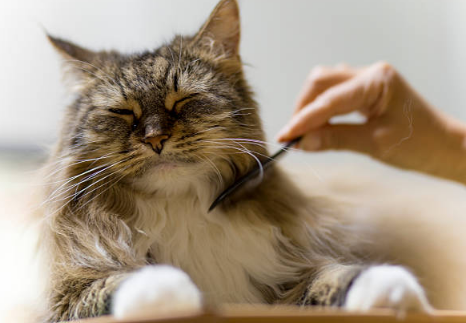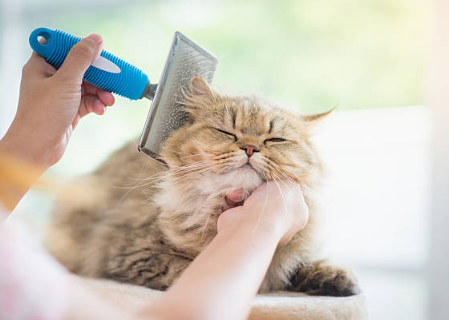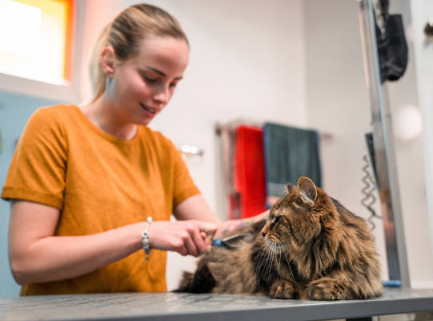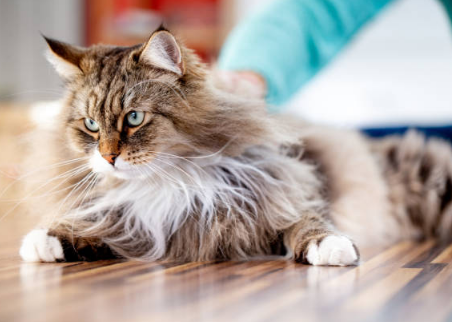Cats are reputed to be effective self-groomers, but that doesn’t mean they don’t need your help to stay clean and healthy. Older, frail, overweight, and long-haired cats are especially prone to tangled hair, which may turn into clumped mats or knotted braids. Not only are these tangles unsightly, but they can also cause discomfort, promote skin diseases, or breed worms, mites, or other pests. While regular brushing and check-ups to prevent tangles are the best way to do so, there are ways to remove tangled fur at home. If all else fails, or if you’re not sure if you have the ability to safely remove tangles, consult a professional esthetician or veterinarian.
Remove Tangles and Pads
1. Keep Your Cat Calm
Removing knotted fur can be a time-consuming and potentially painful process, and many cats don’t respond well to it. It is important that your cat is calm at first (like after a hearty meal) and remains calm as you eliminate knots and tangles. It is better to stop the process and resume at another time than to force a scared or angry cat to accept the task of clearing the tangles.
If you’ve been grooming your cat regularly since childhood, it’s more likely to accept the process of removing the tangles. If your cat refuses to go through the process without scratching, scratching, running, etc., it’s best to leave the matter to a professional groomer or veterinarian.

2. Find and Inspect All Mats
Some tangles, such as the type of braid that appear on the back or sides, are easy to see. However, others may be lurking in hidden places. But it is at least as important to remove these. Check for tangles in areas such as behind the ears, around the groin, between the hind legs, behind the front legs, under the collar, and around the anus.
If the tangle or mat is very large (e.g., larger than the end of your thumb), then it is best to have a professional handle it. If there are any signs of irritation or injury to the adjacent skin, contact the cat’s veterinarian.
3. Use Your Fingers to Solve the Tangle Problem
The first tool to try to eliminate the tangles is located at the end of both arms, which is very convenient. Use your fingers to untie the knots, loosen the larger tangles, and divide the mat into smaller, more manageable sections. For your cat, working with your fingers may reduce pain and stress.
Some experts recommend using a tangle spray or shampoo before attempting to remove tangles. Others don’t think they help much. If you choose to use them, make sure to use a tangle that is specifically designed for pets and not humans.
Sprinkle a little cornstarch or talcum powder over where the knot is tied may help tie the knot.
4. Try to Comb Through the Tangled Parts
Before using more specialized equipment, you can try (after using your fingers) brush off the mats and knots with a regular cat brush or a wide-toothed comb. Use your free hand to grasp the fur closest to the skin and below the tangled areas to limit pulling on the skin. Use short, quick but gentle brushing movements. Brush towards the end of the hair (away from the skin), but start at the end of the mat furthest from the cat’s skin, and slowly return to the skin.
Don’t force it, though. Jerking the messy fur with a brush will not make your cat happy, and in turn your cat will make you unhappy. Continue with other methods.

5. Use Specialized Tools to Handle Stubborn Mats
If your fingers or a regular brush can’t clear the tangles, you still have a variety of options to choose from. Different people use different tools (e.g.,”Furminator”, which is a popular brand of brush), so the process of trial and error may work for you. Of course, you can also consult a cosmetologist or veterinarian for advice.
Various tools such as pad rakes, mat breakers, or mat splitters can help break down large areas of mats into smaller, more manageable pieces. They have sharp edges between their teeth and require a sawing action to get through the mat. They are generally safer than other cutting options because the sharp edges are not exposed, but of course caution should still be taken. Once the mat has been cut into small pieces, continue to use your fingers and/or a brush and comb.
6. When All Else Fails, Cut off the Mat
While the surest way to get rid of stubborn tangles or mats, cutting should often be the last option. Not only will it give your cat bald spots that may take months to fill completely, but you’re also at risk of harming your cat. Cats’ skin is thinner and softer than humans, and they can easily be cut by the friction of scissors, blades, and even scissors. If you are undecided, take your cat to see a professional.
Razor combs (also known as cushion combs) work similarly to regular combs but have recessed blades that shave hair. Use the same short, fast movements as a regular comb and make sure to resist any pulling with your free hand and always stay away from your cat’s skin.
A hair clipper can quickly clean the mat, but make sure you don’t rub your cat’s skin. The friction and even heat of the scissors can damage the skin of the feline.
While scissors may seem like the obvious choice, they are generally not recommended for non-professionals. The risk of cuts or punctures is simply too great. If you do use them, always make sure you have a comb or finger between the scissor blades and your cat’s skin.

7. Let the Professionals Handle the Work
It’s worth repeating: if you have any doubts about your ability to remove tangles or mats without harming your cat, don’t try to do so. Knots usually occur in sensitive areas, such as the abdomen, under the neck, or around the genitals. Don’t risk mistakes that could have serious consequences.
Any good pet groomer will deal with tangled fur on a daily basis and should be able to fix this in most cases. The veterinarian will also remove the pads regularly, especially if there are concerns about skin conditions or other issues related to tangles, and a veterinarian should be consulted.
Prevents Hair from Tangling
Understand the Cat’s Needs
A young, active, healthy shorthair cat may be able to keep itself neat and tidy and needs limited help in preventing tangles. Also, an older, overweight long-haired cat may need to brush its teeth regularly (or even daily) to prevent knots and knots.
Groom Your Cat Regularly
Even if you have a cat that is able to groom itself effectively, getting into the habit of brushing your teeth regularly will make the process easier and more comfortable later when necessary. It is best to start brushing your kitten as soon as possible so that brushing becomes a normal (and preferably pleasant) habit.
- Brushing a shorthair cat is a fairly simple process that can be administered using many types of brushes, although many people prefer “oven mitt” brushes with rubber teeth. Always brush in the direction of your hair.
- Long-haired cats require more specialized tools, such as a “cat rake” (a wide brush with small metal bristles) and a long-toothed comb. Use both tools to reach both surface and deep hairs. Gently comb the hair from your abdomen and neck upwards to your chin. Then, make a section in the middle of the cat’s back and comb the sides.

Bathe the Cat Only When Necessary
Your feline is unlikely to question this: cats benefit from regular grooming, but not from regular bathing. Bathing, especially if it is not dried immediately and thoroughly, is more likely to develop new tangles and tangles. In general, bathe your cat only if it is too sticky, smelly, or dirty.
There’s no shame in letting a professional groomer handle the “kitten bath time”.
Detect Tangles Early
Even with regular grooming, tangles and knots can occur, especially in long-haired cats. That said, the easiest to remove are the ones that are just beginning, so check them regularly (or even daily) when grooming.
Special attention is paid to typical problem areas such as the groin area, back, under the collar, behind the front legs, between the hind legs, and behind the ears.
Regular tangle checks can also be utilized to check the skin for any damage or damage. Check for cuts, bruises, lumps, swelling, redness, etc. If you notice anything unusual, contact your veterinarian.